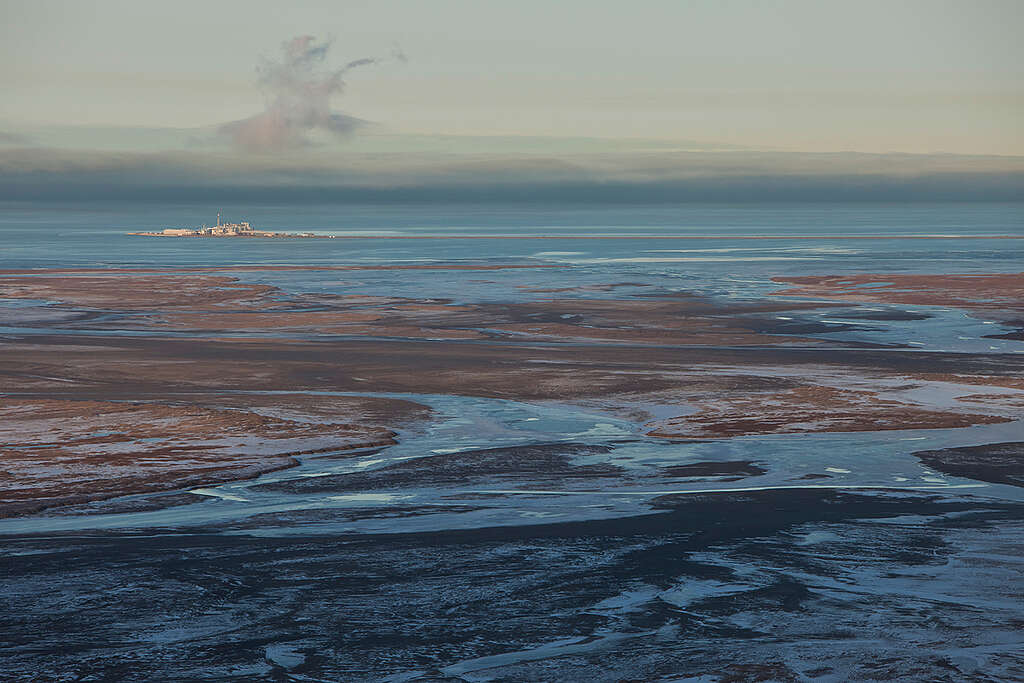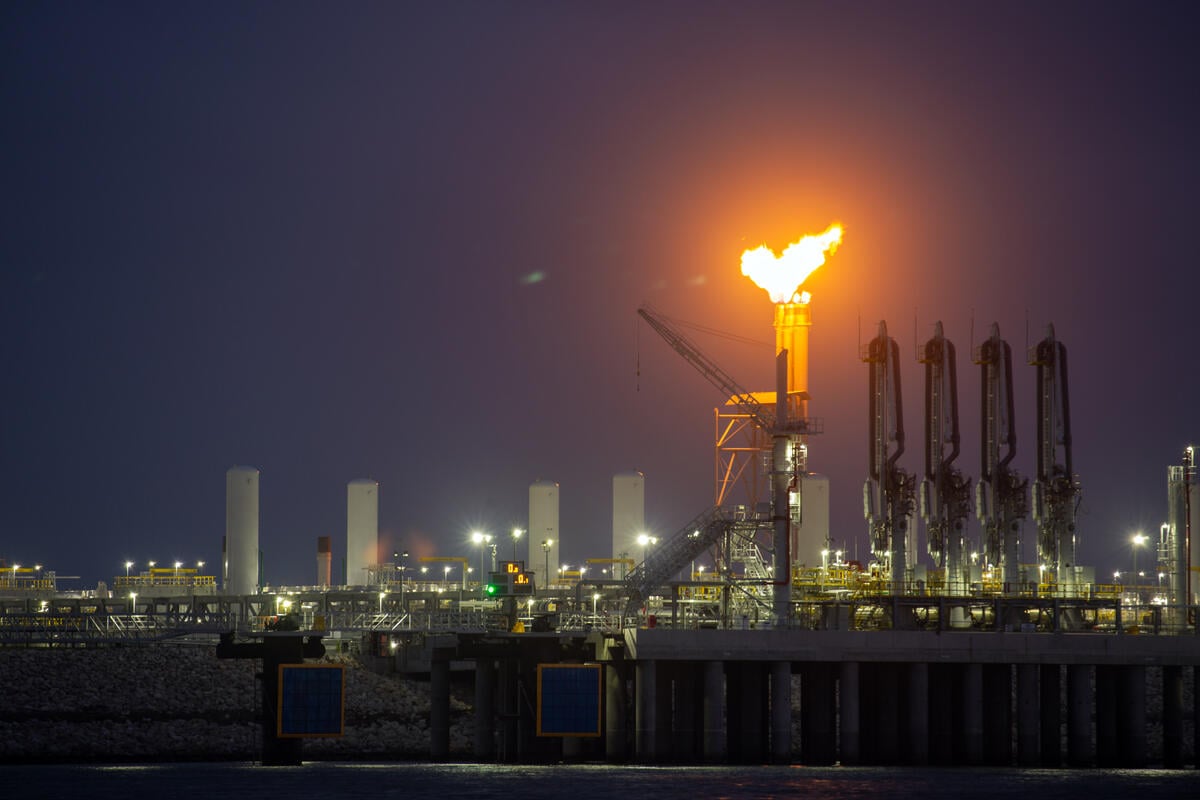
The Alaska LNG mega-project obtained a key authorization from the Department of Energy in April 2023. Greenpeace USA research reveals that the authorization was granted on the basis of a deeply flawed environmental analysis, and consultants who supported the analysis had ties to the gas industry.
Previous Greenpeace USA research revealed that key studies used by the Department of Energy to approve liquefied natural gas export authorizations were prepared with support from gas industry insiders and consultants. The same appears to be true for Alaska LNG’s flawed life cycle analysis, which was ordered by the Department of Energy partly due to an executive order mandating federal agencies to exercise climate leadership.
Supplying the Alaska LNG mega-project will require up to 3.36 billion cubic feet of natural gas production per day, according to official estimates.1 The gas resources on tap to supply this production are not commercially viable without Alaska LNG and its accompanying 800-mile pipeline, which would carry gas from the remote Northern Slope of Alaska to the planned liquefied natural gas (LNG) terminal in Nikiski, southwest of Anchorage. Nevertheless, a key analysis ordered by the Department of Energy (DOE) in 2021 concluded that Alaska LNG would not increase greenhouse gas emissions compared to a scenario where the project does not get built.2
This assessment was the result of comparing Alaska LNG’s projected emissions to a high emissions baseline scenario that is both unlikely and inconsistent with stated climate policies. Greenpeace USA research shows that the analysis was conducted with the help of KeyLogic, a consulting firm with commercial ties to the gas industry. KeyLogic is one of the DOE’s go-to contractors, and, in addition to the Alaska LNG study, it was heavily involved in preparing a 2019 LNG analysis that the DOE has used to justify its track record of universally approving LNG export applications.3 Some KeyLogic staff have worked on DOE projects while simultaneously working for gas companies that the DOE is tasked with regulating.
The DOE’s plan to update the environmental analysis of LNG that informs the public interest determination of LNG exports is a step in the right direction— improvements to this analysis are urgently needed.4 But the Alaska LNG case study serves as a warning that pro-fossil fuel bias remains a risk to the integrity of this crucial update.
Initial approvals of Alaska LNG by FERC and DOE
Because of how the federal government regulates LNG export terminals, Alaska LNG was required to secure approvals from the Federal Energy Regulatory Commission (FERC) and the DOE. Although FERC was the lead agency responsible for Alaska LNG’s environmental impact statement under the National Environmental Protection Act (NEPA) between 2018 and 2020, the DOE would later adopt FERC’s environmental impact statement for the purpose of approving Alaska LNG’s non-free trade association LNG export application under the Natural Gas Act.
Both agencies— but especially FERC— are notorious for using deeply flawed reasoning to circumvent credible environmental concerns. One of the many flaws in FERC’s assessment of Alaska LNG, as pointed out by the Center for Biological Diversity and Earthjustice on behalf of conservation groups including the Sierra Club and the Chickaloon Village Traditional Council in June 2020, was that it did not even mention the project’s upstream or downstream emissions.5 These typically represent the vast majority of lifecycle emissions associated with LNG exports.
Although the DOE adopted FERC’s environmental impact statement in August 2020,6 it subsequently granted a rehearing request sought by the Sierra Club to further assess the project’s environmental impacts in April 2021.7 Consequently, the DOE stated that it would prepare a new, supplemental environmental impact statement (SEIS) consistent with NEPA that would include a life cycle analysis of Alaska LNG’s Asia-bound gas exports.8 It was at this stage that KeyLogic entered the picture, as a support contractor for the life cycle analysis that DOE would commission from the National Energy Technology Laboratory (NETL).
Factors leading DOE to order a new Alaska LNG environmental study
It is important to understand why the DOE granted the Sierra Club’s rehearing request in the first place. It boils down to two factors.
First, the transition from a Trump administration to a Biden administration in January 2021 came with a string of climate-focused executive orders, and meant that the DOE and its sub-agencies would be under new leadership. Most notably, Executive Order 14008 of January 27, 2021 (“Tackling the Climate Crisis at Home and Abroad”) committed to “organize and deploy the full capacity of [the federal government’s] agencies to combat the climate crisis” and, further, to “drive assessment, disclosure, and mitigation of climate pollution and climate-related risks in every sector” of the U.S. economy.9 The DOE explicitly referred to this and another climate-focused executive order in its rehearing order for Alaska LNG.
Second, the Sierra Club’s rehearing request demonstrated, based on previous authorization decisions, that it was outside the DOE’s usual practice to dismiss the life cycle emissions associated with LNG exports.10 Typically, the DOE had used “general studies” assessing the life cycle emissions of LNG exports from the lower 48 states to inform the public interest determination of LNG projects. Due to Alaska LNG’s location, however, none of these studies would have been relevant to Alaska LNG. Consequently, the Sierra Club argued that a new life cycle emissions study was warranted, and the DOE acquiesced.
The outcome of the Alaska LNG study: data-washing and defiance of common sense
The Alaska LNG study that NETL prepared with support from KeyLogic is strongly suggestive of “data-washing,” a practice similar to greenwashing.11 Oil & gas companies use data-washing to make credible-sounding environmental claims that rely on faulty assumptions or incomplete analysis. With data-washing, there is often a sleight of hand: complex models and equations are used to distract attention from how the underlying study design has been carefully crafted to produce industry-favoring results.
The Alaska LNG analysis has the telltale features of data-washing. Behind a smokescreen of emissions estimation methods and technical jargon, there is a crucial error: the authors assume (without justification) that if Alaska LNG is not built, the same volume of gas would be produced and exported from the lower 48 states instead.12 There is no evidence provided to support this assertion; and, at a conceptual level, it is basically a license to pollute based on the assumption that “if we don’t do it, someone else will.” As a result, the study maintains that even though Alaska LNG would emit up to 2.7 billion metric tons of greenhouse emissions over its lifetime (ten times the amount of the Willow Project), it would actually save on emissions compared to a scenario where the project doesn’t get built.
A 2022 report from Earthjustice and the Stockholm Environmental Institute shows that this type of approach has a bevy of scientific shortcomings; and although there is a history of agencies using similar reasoning to assess coal and oil projects under NEPA, over time this reasoning has been increasingly rejected by the courts.13 One problem is that “the inherent uncertainty of estimating the counterfactual for a single project – what will happen if the project is not approved […] leaves open the possibility that conclusions can be manipulated by project proponents to reach a desired result.” Another is that it “centers on a comparison between the project and a ‘no action’ alternative reflecting a high-emissions ‘business as usual’ scenario that is neither likely, nor tolerable, nor consistent with stated policies.” In other words, the analysis “pretends as if the nation, and other nations, have not made a commitment to stop global warming.” Lastly, the authors point out that aside from greenhouse gas emissions analyses “it is hard to find any other analytical context in which known environmental or health harm is dismissed on the theory that ‘if we don’t do it, someone else will.’” The same rationale is not applied, for example, when federal agencies assess water pollution or species disturbance under NEPA.
In June 2022, the DOE published the draft SEIS for Alaska LNG, which adopts the findings of the flawed life cycle analysis prepared by NETL and KeyLogic.14 During the public comment period, multiple commenters, including the Environmental Protection Agency (EPA), pointed out that assumptions underlying the life cycle analysis, and that largely drove the results, were incorrect..15, 16 In response, the DOE made an important change to the final SEIS. Instead of concluding that Alaska LNG would definitely reduce emissions compared to the baseline scenario, the final SEIS presents two opposing baseline scenarios: one that is unchanged, presenting Alaska LNG as a net climate benefit (“No Action Alternative 1”), and a second that assumes Alaska LNG’s life cycle emissions would be 100% additional, adding up to 1.9 billion metric tons of CO2e to the atmosphere cumulatively (“No Action Alternative 2”).17 Ultimately, however, the DOE granted Alaska LNG’s export authorization based on the reasoning that “while both [assumptions] are unlikely, in DOE’s judgment the greenhouse emissions and related climate impacts associated with Alaska LNG’s exports … are likely to be closer to the difference between No Action Alternative 1 and the project scenarios.”18
It is thanks to pushback from the EPA and civil society groups that the final SEIS presents a view of Alaska LNG that considers the potential for LNG exports to increase global emissions at all. But the DOE’s decision to present two radically different calculations just to dismiss both of them is illogical, and fails to achieve the goals of NEPA and the Natural Gas Act. In future analyses, the DOE must close the door on data-washing to prevent decisions that set us back from achieving our climate goals.
The Alaska LNG analysis, like DOE’s 2019 environmental study of LNG, was supported by a KeyLogic team with major oil and gas company clients
What makes the Alaska LNG life cycle analysis even more interesting is that it fits into a pattern of analyses commissioned by the DOE and supported by KeyLogic that are biased in favor of the LNG industry, including the 2019 environmental study that underpins the DOE’s public interest determination for LNG exports.
Since the early 2010s, the DOE has used periodically updated economic and environmental analyses of LNG that it commissions from national laboratories and private contractors to help determine whether LNG export applications are consistent with the public interest. The DOE’s most recent environmental analysis of LNG, which was finalized in 2019, used very low estimates of methane leakage in the LNG supply chain and failed to consider how increased LNG exports can drive up total fossil fuel use.19
In a previous investigation, published in April 2024, Greenpeace USA found that the 2019 study was supported by KeyLogic’s life cycle analysis team, which was simultaneously offering services to oil and gas industry clients.20 At least three KeyLogic employees who were listed among the authors of the study were also performing commercial work for Cheniere and Saudi Aramco between 2017 and 2020. Moreover, of the four KeyLogic authors, all had, or later developed, significant connections to the oil and gas sector: the project lead had previously worked at EQT Corporation— a company that has actively opposed LNG restrictions— and the other three authors went on to full-time positions at Cheniere, Saudi Aramco Americas, and GTI Energy, a pro-gas think tank.
KeyLogic appears to have also played a large role in the flawed Alaska LNG analysis. Eight KeyLogic employees— evidently from the same team that did business with major oil and gas companies— were listed among the ten authors of the analysis. One of the authors was formerly a commercial advisor for ExxonMobil,21 which was a joint owner of Alaska LNG until late 2016 and signed a gas supply deal with the project in 2018.22, 23 ExxonMobil’s major stake in the project is underscored by a 2019 statement made by ExxonMobil Alaska President Darlene Gates: “As the largest holder of discovered gas resources on the North Slope, we have been working for decades to tackle the challenges of bringing Alaska’s gas to market.”24
Conclusion
The Alaska LNG case study, like many other examples, both demonstrates how federal analyses are vulnerable to data-washing and raises questions about the impartiality of the DOE’s record of LNG export authorizations. Although the federal government’s announcement in January to update the LNG studies that inform the public interest determination is a step in the right direction, stringent integrity and oversight measures still need to be taken to prevent the updated analyses from being mismanaged. These measures should include facilitating an inclusive process with meaningful participation from environmental justice communities, experts, and other stakeholders outside the gas industry.
Moreover, under NEPA, FERC and the DOE should downweight and avoid the usage of emissions displacement analytic approaches, which depend on highly uncertain assumptions and are vulnerable to manipulation. If and where baselines are needed, FERC and the DOE should use baseline scenarios that comply with global and domestic climate policies and agreements. Lastly, with respect to the DOE’s forthcoming updated environmental analysis of LNG, as well as NEPA, the DOE should yield to the EPA’s relevant expertise in matters that concern emissions accounting and climate change.
References
1 Appendix C: Life Cycle Greenhouse Gas Emissions for Alaska LNG, in Alaska LNG Final Supplementary Environmental Impact Statement (DOE/EIS-0512-S1). 2023. Department of Energy, January 6. https://www.energy.gov/nepa/articles/doeeis-0512-s1-final-supplemental-environmental-impact-statement-january-6-2023
2 Ibid
3 Chang, A. 2024. Department of Energy used gas industry insiders and consultants to build the case for soaring LNG exports. Greenpeace USA, April 8. https://prod.greenpeaceusa.info/usa/research/doe-lng-studies-analysis/
4 The Temporary Pause on Review of Pending Applications to Export Liquefied Natural Gas. 2024. Department of Energy, February 23. https://www.energy.gov/fecm/articles/temporary-pause-review-pending-applications-export-liquefied-natural-gas
5 Request for Rehearing of Order Granting Authorization of the Alaska LNG Project, FERC Docket No. CP17-178-000. 2020. Center for Biological Diversity and Earthjustice, June 22. https://www.biologicaldiversity.org/programs/oceans/pdfs/Center-et-al-AK-LNG-Request-for-Rehearing.pdf
6 Final Opinion and Order Granting Long-Term Authorization To Export Liquefied Natural Gas to Non-Free Trade Agreement Nations, FE Docket No. 14-96-LNG. 2020. Department of Energy, August 20. https://www.energy.gov/sites/default/files/2020/08/f77/ord3643a.pdf
7 Order on Rehearing, FE Docket No: 14-96-LNG. 2021. Department of Energy, April 15. https://www.energy.gov/sites/default/files/2021-04/ord3643b.pdf
8 Notice of Intent to Prepare a Supplemental Environmental Impact Statement for the Alaska LNG Project. 2021. Department of Energy. https://www.energy.gov/nepa/articles/doeeis-0512-s1-notice-intent-july-2-2021
9 Executive Order on Tackling the Climate Crisis at Home and Abroad. 2021. White House, January 27. https://www.whitehouse.gov/briefing-room/presidential-actions/2021/01/27/executive-order-on-tackling-the-climate-crisis-at-home-and-abroad/
10 Request for Rehearing, FE Docket No. 14-96-LNG. 2020. Sierra Club, September 21. https://www.energy.gov/fecm/articles/alaska-lng-project-llc-fe-dkt-no-14-96-lng
11 Westervelt, A. 2024. Management consultancies play a massively under-reported, yet extremely clutch role in greenwashing and lobbying… June 27. https://www.linkedin.com/posts/amywestervelt_management-consultancies-play-a-massively-activity-7212113030078242817-uB14/
12 Appendix C: Life Cycle Greenhouse Gas Emissions for Alaska LNG, in Alaska LNG Draft Supplementary Environmental Impact Statement (DOE/EIS-0512-S1). 2022. Department of Energy, June 24. https://www.energy.gov/nepa/articles/doeeis-0512-s1-draft-supplemental-environmental-impact-statement-june-24-2022
13 Hasselman, J. & Erickson, P. 2022. NEPA review of fossil fuels projects – principles for applying a “climate test” for new production and infrastructure. Earthjustice and the Stockholm Environmental Institute, May 3. https://www.sei.org/publications/nepa-fossil-fuels-climate-test/
14 Summary, in Alaska LNG Draft Supplementary Environmental Impact Statement (DOE/EIS-0512-S1). 2022.
15 Appendix D: Comment Response Document, in Alaska LNG Final Supplementary Environmental Impact Statement (DOE/EIS-0512-S1). 2023. Department of Energy, January 6. https://www.energy.gov/nepa/articles/doeeis-0512-s1-final-supplemental-environmental-impact-statement-january-6-2023
16 Amended Record of Decision (DOE/EIS-0512-S1). 2023. Department of Energy. https://www.energy.gov/nepa/articles/doeeis-0512-s1-amended-record-decision
17 Summary, in Alaska LNG Final Supplementary Environmental Impact Statement (DOE/EIS-0512-S1). 2023.
18 Amended Record of Decision (DOE/EIS-0512-S1). 2023.
19 See, for example, 2019 comments from Sierra Club.
20 Chang, A. 2024.
21 The author who was previously a commercial advisor for ExxonMobil is Krista Kirchner-Ortiz, according to LinkedIn.
22 ExxonMobil, BP, ConocoPhilips back out of Alaska LNG. 2016. Offshore Energy, August 30. https://www.offshore-energy.biz/exxonmobil-bp-conocophilips-back-out-of-alaska-lng/
23 Bradner, T. 2018. ExxonMobil strikes deal with Alaska to feed LNG project. S&P Global, September 10. https://www.spglobal.com/commodityinsights/en/market-insights/latest-news/natural-gas/091018-exxonmobil-strikes-deal-with-alaska-to-feed-lng-project
24 ExxonMobil Agrees To Supply Gas for Alaskan LNG Export Project. 2019. Journal of Petroleum Technology, October 23. https://jpt.spe.org/exxonmobil-agrees-supply-gas-alaskan-lng-export-project



